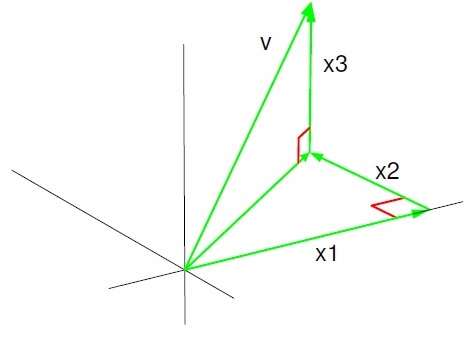9.2: Norms
( \newcommand{\kernel}{\mathrm{null}\,}\)
The norm of a vector in an arbitrary inner product space is the analog of the length or magnitude of a vector in Rn. We formally define this concept as follows.
Definition 9.2.1. Let V be a vector space over F. A map
‖⋅‖:V→Rv↦‖v‖
is a norm on V if the following three conditions are satisfied.
- Positive definiteness: ‖v‖=0 if and only if v=0;
- Positive Homogeneity: ‖av‖=|a|‖v‖ for all a∈F and v∈V;
- Triangle inequality: ‖v+w‖≤‖v‖+‖w‖ for all v,w∈V.
Remark 9.2.2. Note that, in fact, ‖v‖≥0 for each v∈V since
0=‖v−v‖≤‖v‖+‖−v‖=2‖v‖.
Next we want to show that a norm can always be defined from an inner product ⟨⋅,⋅⟩ via the formula
‖v‖=√⟨v,v⟩ for all v∈V.
Properties 1 and 2 follow easily from Conditions~1 and 3 of Definition~9.1.1. The triangle inequality requires more careful proof, though, which we give in Theorem~9.3.4??? in the next chapter.
If we take V=Rn, then the norm defined by the usual dot product is related to the usual notion of length of a vector. Namely, for v=(x1,…,xn)∈Rn, we have
‖v‖=√x21+⋯+x2n.
We illustrate this for the case of R3 in Figure 9.2.1.

Figure 9.2.1: The length of a vector in R3 via equation 9.2.1.
While it is always possible to start with an inner product and use it to define a norm, the converse requires more care. In particular, one can prove that a norm can be used to define an inner product via Equation 9.2.1 if and only if the norm satisfies the Parallelogram Law (Theorem 9.3.6~???).
Contributors
- Isaiah Lankham, Mathematics Department at UC Davis
- Bruno Nachtergaele, Mathematics Department at UC Davis
- Anne Schilling, Mathematics Department at UC Davis
Both hardbound and softbound versions of this textbook are available online at WorldScientific.com.


